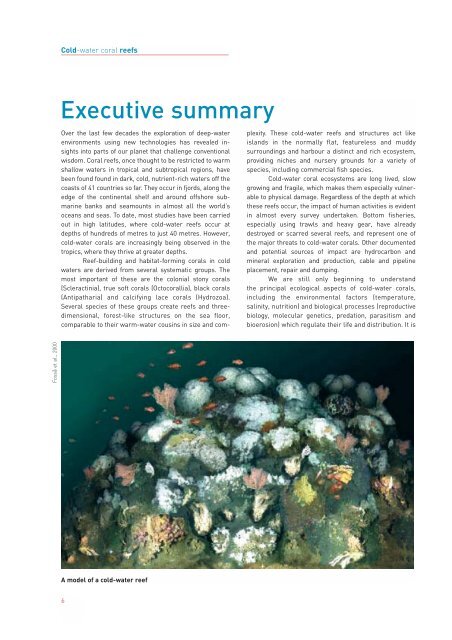Cold-water coral reefs - WWF UK
Cold-water coral reefs - WWF UK
Cold-water coral reefs - WWF UK
Create successful ePaper yourself
Turn your PDF publications into a flip-book with our unique Google optimized e-Paper software.
<strong>Cold</strong>-<strong>water</strong> <strong>coral</strong> <strong>reefs</strong><br />
Executive summary<br />
Over the last few decades the exploration of deep-<strong>water</strong><br />
environments using new technologies has revealed insights<br />
into parts of our planet that challenge conventional<br />
wisdom. Coral <strong>reefs</strong>, once thought to be restricted to warm<br />
shallow <strong>water</strong>s in tropical and subtropical regions, have<br />
been found found in dark, cold, nutrient-rich <strong>water</strong>s off the<br />
coasts of 41 countries so far. They occur in fjords, along the<br />
edge of the continental shelf and around offshore submarine<br />
banks and seamounts in almost all the world’s<br />
oceans and seas. To date, most studies have been carried<br />
out in high latitudes, where cold-<strong>water</strong> <strong>reefs</strong> occur at<br />
depths of hundreds of metres to just 40 metres. However,<br />
cold-<strong>water</strong> <strong>coral</strong>s are increasingly being observed in the<br />
tropics, where they thrive at greater depths.<br />
Reef-building and habitat-forming <strong>coral</strong>s in cold<br />
<strong>water</strong>s are derived from several systematic groups. The<br />
most important of these are the colonial stony <strong>coral</strong>s<br />
(Scleractinia), true soft <strong>coral</strong>s (Octo<strong>coral</strong>lia), black <strong>coral</strong>s<br />
(Antipatharia) and calcifying lace <strong>coral</strong>s (Hydrozoa).<br />
Several species of these groups create <strong>reefs</strong> and threedimensional,<br />
forest-like structures on the sea floor,<br />
comparable to their warm-<strong>water</strong> cousins in size and complexity.<br />
These cold-<strong>water</strong> <strong>reefs</strong> and structures act like<br />
islands in the normally flat, featureless and muddy<br />
surroundings and harbour a distinct and rich ecosystem,<br />
providing niches and nursery grounds for a variety of<br />
species, including commercial fish species.<br />
<strong>Cold</strong>-<strong>water</strong> <strong>coral</strong> ecosystems are long lived, slow<br />
growing and fragile, which makes them especially vulnerable<br />
to physical damage. Regardless of the depth at which<br />
these <strong>reefs</strong> occur, the impact of human activities is evident<br />
in almost every survey undertaken. Bottom fisheries,<br />
especially using trawls and heavy gear, have already<br />
destroyed or scarred several <strong>reefs</strong>, and represent one of<br />
the major threats to cold-<strong>water</strong> <strong>coral</strong>s. Other documented<br />
and potential sources of impact are hydrocarbon and<br />
mineral exploration and production, cable and pipeline<br />
placement, repair and dumping.<br />
We are still only beginning to understand<br />
the principal ecological aspects of cold-<strong>water</strong> <strong>coral</strong>s,<br />
including the environmental factors (temperature,<br />
salinity, nutrition) and biological processes (reproductive<br />
biology, molecular genetics, predation, parasitism and<br />
bioerosion) which regulate their life and distribution. It is<br />
Fosså et al., 2000<br />
A model of a cold-<strong>water</strong> reef<br />
6
















